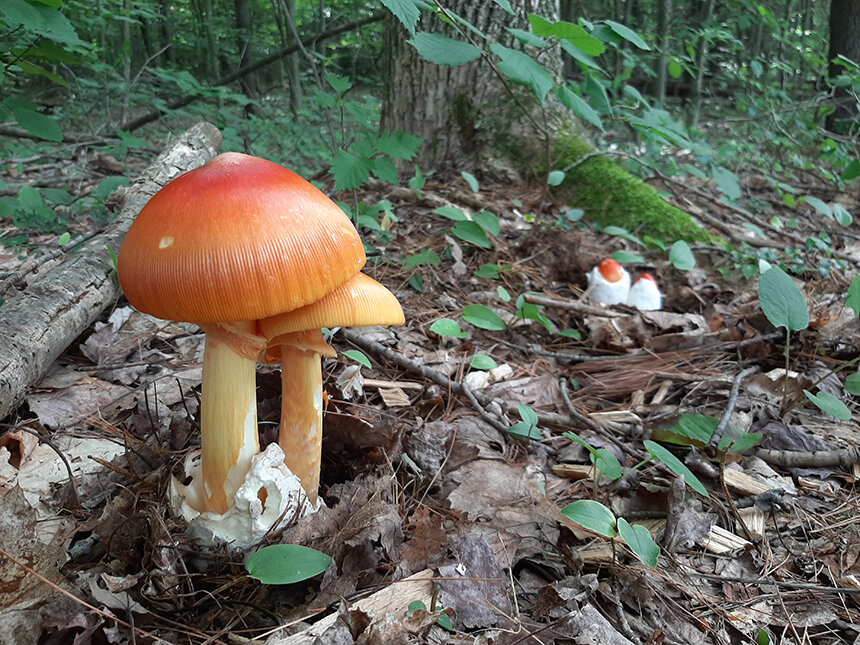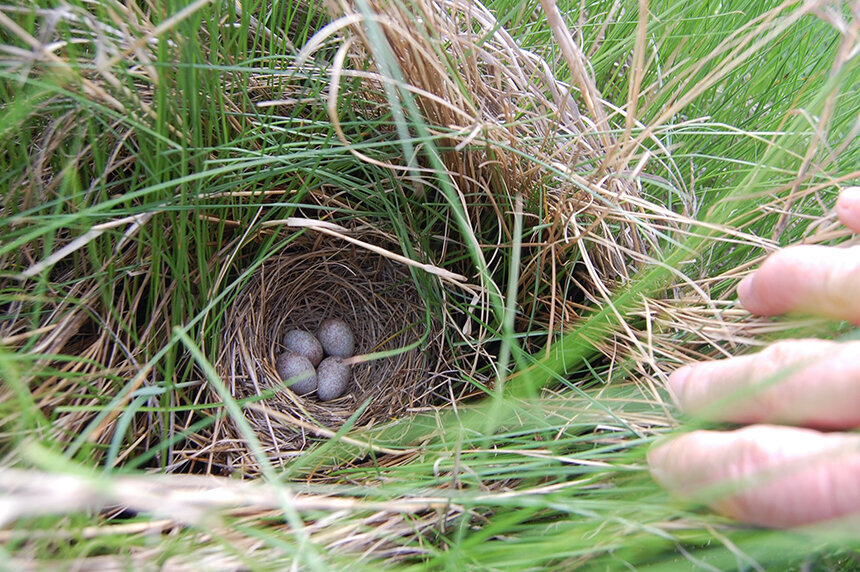Soggy July was Good and Bad for Wildlife, Environment
By TODD McLEISH/ecoRI News
contributor
 |
| Last month’s rains were especially good for Jackson’s slender amanita, a brightly colored edible mushroom that is usually hard to find. (Ryan Bouchard) |
Rhode Island experienced the third-rainiest July on record, with most areas receiving more than twice the average monthly precipitation and some areas receiving much more, especially in the northwest corner of the state. Local scientists said all that rain likely had an impact on wildlife and the environment, in both positive and negative ways.
In many neighborhoods, it was the
mushrooms that were the most visible winners. Mushrooms of numerous species
sprouted from lawns, gardens, forests, meadows and elsewhere in huge numbers.
Abundant rainfall brings to life the underground portion of a fungi — called
the mycelium — resulting in the production of mushrooms, according to Ryan Bouchard, founder
of the Rhode Island-based Mushroom Hunting Foundation.
“You end up with larger flushes of
mushrooms, species not normally seen in such abundance, and species seen in
uncharacteristic size,” he said. “This wasn’t just an extra rainy July, though.
It was a comeback from the prolonged terrible mushroom season of 2020 when we
had a lack of rain throughout the year that left the mycelium mostly dormant
and weakened.”
The near-daily July rains provided
what Bouchard called “a kick in the pants to the mycelia to get back into
action.” He said it was an especially good month for Jackson’s slender amanita,
a brightly colored edible mushroom that is usually hard to find but which was
abundant in many places in July. Black trumpet mushrooms and chantarelles also
had a major comeback following a year in which Bouchard saw only one.
Other wildlife didn’t fare nearly as
well as the mushrooms, however. Butterflies, moths and dragonflies were barely
noticed in many areas for much of the month, though that doesn’t mean the
insects were killed by the rain. Most were probably just in hiding. They are
typically visible only during sunny days, and since July had few sunny days,
most species did not make their presence known.
Butterflies and moths in their caterpillar stages, though, may have succumbed due to the rain. Martin Wencek, a butterfly expert and a supervisor in the Freshwater Wetlands Division of the Rhode Island Department of Environmental Management, said any insect that goes through a caterpillar stage faces high mortality during especially wet years.
“The dampness can promote bacterial
growth that does them in effectively,” he said.
An isolated month of extreme rain
isn’t likely to have a serious impact on dragonflies, said Virginia Brown,
author of Dragonflies and Damselflies of
Rhode Island. But if torrential rains result in dam breaches, it
could affect dragonfly populations and their habitats.
“The problem from an odonate
[dragonfly and damselfly] perspective is that when a dam breaches, the water it
holds back — usually in the form of a pond or reservoir — is released
downstream and, poof, there goes the pond habitat and all the aquatic critters
like eggs and larvae in the water,” Brown said. “The pond becomes a stream
channel, and then the hydrology and vegetation change.”
Brown believes several populations
of rare damselflies disappeared from the Ocean State in just this way as a
result of the floods of March 2010.
On the other hand, she said, “all
this rain will probably result in high mosquito populations, which will mean
more food for odonates.”
 |
| Rising waters being caused by more frequent and heavy rains are destroying saltmarsh sparrow nests or drowning chicks before they have a chance to find higher ground. (Todd McLeish/for ecoRI News) |
More mosquitoes means more food for insect-eating birds as well. But since the rains occurred during the peak of bird nesting season, it may have negatively affected the ability of some birds to fledge their young successfully. According to Steven Reinert, an ornithologist who monitors the nests of one of Rhode Island’s most-imperiled birds in a marsh on the Bristol/Warren line, when heavy rains coincide with extreme high tides in salt marshes in mid-summer, saltmarsh sparrow nests can become flooded.
“Rains coinciding with flooding
events not only raises the elevation of the floodwaters, but also keeps water
levels at or near nest level for longer periods of time,” he said. “Thus, the
extensive rain of July likely cost the lives of nestling saltmarsh sparrows at
Jacob's Point, but the extent of damage is impossible to quantify.”
The abundant precipitation provided
a significant boost to lawns and wild plants, but many cultivated plants,
especially vegetables, struggled to survive. Heather Faubert, who directs the Plant Protection Clinic at the University of Rhode Island,
said the rains led to significant impacts on tomatoes, peppers, onions,
carrots, squash and other varieties from foliar diseases. Many fruiting shrubs
were affected by pest insects as well.
“Spotted-wing drosophila [a
nonnative fruit fly] love high humidity, so they are doing great infesting
blueberries, blackberries and raspberries,” Faubert said.
Water quality in area lakes, ponds
and streams was likely affected by the abundant rainfall, too, but not always
in the same way. Elizabeth Herron of the URI Watershed Watch program said some lakes
and ponds receive contamination from stormwater runoff, while others that are
already contaminated may be improved by having stormwater flush out the
contaminated water.
“Increased runoff does mean we are seeing higher levels of bacteria in many of our sites, even in rural areas, after rainfall events,” she said.
“We are also seeing some increased staining
in our lakes and ponds due to water being flushed out of wetlands. Tannic acids
often color the water like tea or even coffee. The darker stained water reduces
water clarity and may impact algal and plant growth. In some places that can be
a good thing, in other places that reduces productivity, potentially limiting
growth of fish, zooplankton and other critters.
“In other words, it is all very
complicated. But ultimately I would argue that having more water in July is
preferable for water quality than drought.”
Rhode Island resident and author
Todd McLeish runs a wildlife blog.